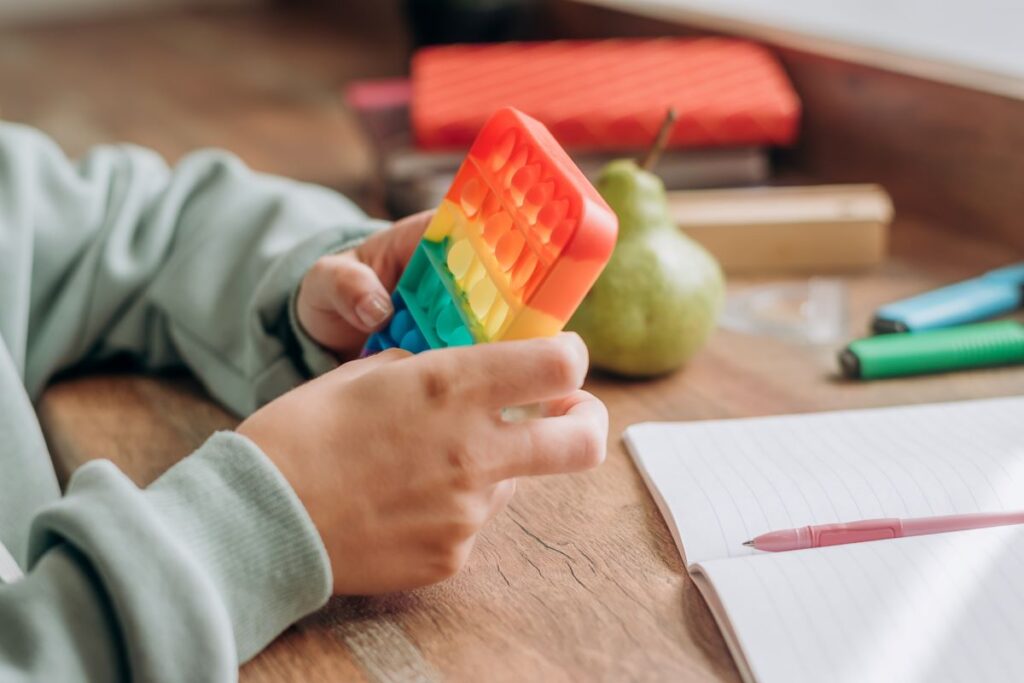Have you ever observed a student tapping a pencil, bouncing a leg, or constantly shifting in their seat and wondering if they were truly absorbing the lesson?
While seeing this common sight in classroom may bring up the initial instinct to curb the movements, it has been shown for some students that this fidgeting isn’t always a distraction. It can be a crucial component of their learning process. This is a fascinating science, and why students fidget can overlap with their ability to focus and learn.
Imagine a middle school student struggling to concentrate during a lesson on fractions. To an outside observer, it may seem as though this student isn’t paying attention because she is twisting a paperclip in her hands and bouncing her leg rhythmically under the desk.
These seemingly distracting movements might actually be the very thing that is helping her brain stay engaged and process the information she is being presented.
This phenomenon lies in the reticular activating system (RAS) within the brain. This neuron network in the brainstem regulates attention and alertness, playing a very vital role.
Think of the RAS as the brains “on” switch for focus. Conditions like Attention-Deficit/Hyperactivity Disorder (ADHD), cause RAS to not function in the same way, which can lead to difficulties in maintaining optimal levels of alertness and attention.
How Fidgeting Can Help
These small motor movements can serve as a form of self-regulation for some students who struggle with maintaining focus. ADHD fidgeting is very common for this reason.
Increasing Stimulation Levels
Fidgeting can provide a source of sensory input that helps to stimulate the RAS, bringing the brain to a more optimal level of alertness needed for concentration. Physical movement can counteract feelings of drowsiness or inattentiveness.
Channeling Excess Energy
For students with higher levels of energy, fidgeting can provide an outlet for that energy, preventing it from becoming a larger distraction that disrupts their focus and the learning environment.
Improving Working Memory
Some studies indicate that subtle motor activity can actually improve working memory capacity in individuals who tend to be more restless. The movement might help to keep the brain engaged and facilitate the processing of information.
Reducing Cognitive Overload
When faced with complex information, fidgeting might serve as a way for the brain to manage cognitive load by providing a secondary focus that prevents overwhelming the system.
Practical Insights for Educators
Understanding the science behind fidgeting can lead to more inclusive and effective classroom management strategies. Instead of viewing all movement as disruptive, consider these approaches:
- Offer Flexible Seating Options: Provide choices like wobble chairs, stability balls, or standing desks that allow for movement while learning.
- Integrate Movement Breaks: Incorporate short bursts of physical activity into lessons to help all students regulate their energy levels and improve focus.
- Provide Fidget Tools: Offer quiet, non-disruptive fidget tools like stress balls, textured pencil grips, or tangle toys that students can use discreetly.
- Observe and Understand Individual Needs: Pay attention to which students seem to benefit from movement and work with them to find appropriate strategies.
- Educating Your Students: Help students understand why they might fidget and how it can sometimes be a helpful tool for their own learning.
While fidgeting can be a helpful self-regulation tool for some, it’s also important to acknowledge that for others, or in certain contexts, it can inadvertently become a source of distraction.
Excessive or disruptive fidgeting, such as loud tapping or large movements, can draw attention away from the learning task for both the individual and their classmates.
It might also signal underlying anxiety or restlessness that could benefit from more direct support and coping strategies. The goal, therefore, isn’t to eliminate all movement, but rather to guide students towards utilizing subtle, non-disruptive forms of movement when needed, while also developing self-awareness regarding when fidgeting might be hindering their own or others’ learning.
By fostering this awareness, we empower students to consciously manage their movements in a way that ultimately supports their focus and engagement. It’s crucial to differentiate between purposeful movement that aids focus and disruptive behaviors that hinder learning. The key lies in observation, understanding the underlying neurological processes, and creating a learning environment that accommodates diverse needs.
By recognizing the science behind the wiggle, we can move towards a more nuanced and supportive approach to student engagement and ultimately foster a more effective learning experience for all.
Educators never stop learning; check out our available graduate degree programs to hone your skills and promote lifelong learning and academic excellence.




